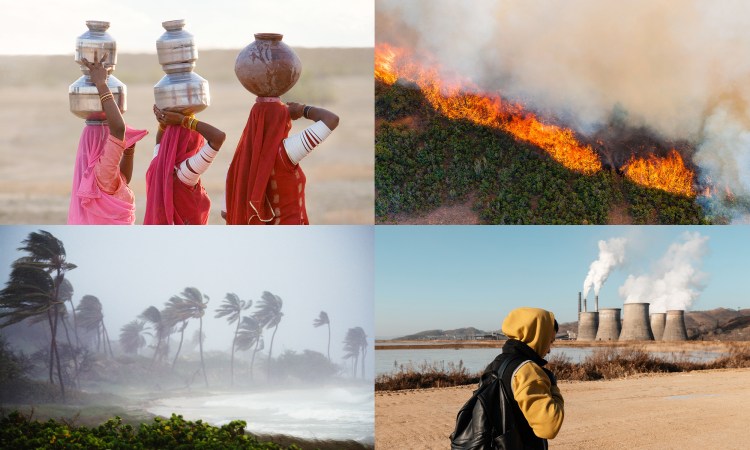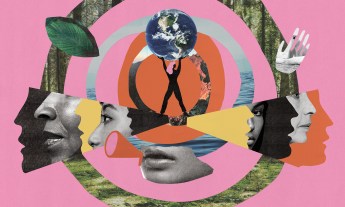
You’ve probably heard of the income gap — that vast wage difference between the haves and have-nots. Well, there’s also a climate gap.
Here’s an example: In August 2017, Hurricane Harvey made landfall in Texas, and much of Houston, one of America’s most racially diverse cities, was submerged underwater. In the months that followed, the city’s poorest neighborhoods were the slowest to recuperate. Not only did low-income and minority households experience more extensive flooding, but wealthier, whiter communities also received more recovery funding.
This disparity is playing out in cities around the world as extreme weather events become more frequent and severe due to climate change. Between 2000 to 2019, 7,348 major natural disasters killed 1.23 million people worldwide — but they didn’t affect everyone equally. Low-income countries logged the highest number of deaths per disaster, according to a report by the UN Office for Disaster Risk Reduction.
“We are all equally exposed to environmental disasters, but some of us have better resources to rebuild or even shelter from these disasters,” says University of Georgia climate scientist J. Marshall Shepherd PhD. “Poor people just don’t have that adaptability.”
Here’s how extreme weather hits vulnerable communities the hardest — and how we can close the climate gap.
This past decade was the hottest ever recorded — and low-income communities really felt the heat.
The year 2020 was one of the hottest on record, and the temperatures are only expected to go higher. By 2050, an estimated 255,000 people could die annually from heatwaves, according to the World Health Organization. By 2070, more than three billion people could be living in temperatures as hot as the Sahara, and the worst affected regions are also some of the world’s poorest with fewer resources to cope.
“Of the 2.8 billion people living in the hottest parts of the world, only 8 percent currently have air conditioners, compared with 90 percent of people in the US and Japan,” according to a report by Radhika Lalit and Ankit Kalanki for the World Economic Forum.
But even in wealthier countries, there are significant disparities. In many parts of the US, for example, poor people have less access to shade. Black people are 52 percent more likely than whites to live in areas without tree cover — this increases their heat risk because trees provide shade from intense heat and reduce air and noise pollution. They also have fewer resources to cope with higher temperatures. For example, Black households in urban areas are less likely to have access to air conditioning and transportation compared to white households.
2020 also saw an unprecedented wildfire season in the US and Australia. In California, for example, fires razed 4.78 million acres of land in 2020, more than double the previous record-high of 1.98 million acres. In 2018, a group of researchers at the University of Washington and The Nature Conservancy looked at census data, and found that Black, Latino and Native American people are more vulnerable to wildfires than whites for numerous reasons. “In California, for example, many individuals in rural areas, low-income neighborhoods and immigrant communities do not have access to the resources necessary to pay for insurance, rebuilding or continual investment in fire safety, thereby increasing their vulnerability to wildfire,” the study authors wrote.
Something similar occurred across the globe in Australia, where over 12.35 million acres of land burned between 2019 and 2020. Researchers found that Aboriginal communities were overrepresented in the fire-damaged areas and they’ve historically been left out of the public responses to bushfires.
Water scarcity is threatening every continent, but the poor and disenfranchised are least likely to have clean water.
Intensifying storms, flooding, sea-level rise and drought imperil one of humanity’s most essential resources: Water. “Wherever you are in the world, it’s the poorest and least powerful who are most often without clean water,” according to a report by WaterAid, a nonprofit dedicated to water, sanitation and hygiene. “That means those who are older, ill, disabled, who live in a remote or rural location or have been displaced, or who are of a caste, ethnicity or religion likely to be discriminated against.”
In India, for instance, overflowing waste and sewage systems often contaminate rivers during periods of increased rain and flooding (which are worsening due to climate change). An estimated 70 percent of the country’s surface water is now polluted and unsafe for drinking. Among India’s poor, members of the lower caste (a social segregation system) have the least access to clean drinking water, which can cause life-threatening illnesses like typhoid, hepatitis and diarrhea.
Water-related natural disasters also harm marginalized communities. For example, when Hurricane Katrina struck New Orleans in 2005, Black people represented 84 percent of missing people — more than double the missing rate for whites. They also made up 46 percent of the population in damaged areas compared to 26 percent in undamaged areas. More than a decade after the disaster, many Black neighborhoods were still struggling to rebuild.
In other parts of the world, the water is drying up. Girls and women in low-income communities — who spend 40 billion hours a year collecting water — are particularly vulnerable. They’re often forced to walk long distances through remote areas. In addition to physical stress on the body, these women are at higher risk of sexual assault and less likely to attend school or work.
Air pollution kills millions of people every year — but almost all of these deaths occur in low- and middle-income countries.
How is air quality connected to climate change? “Because air pollution and greenhouse gases are often released from the same sources, cutting greenhouse gas emissions in an effort to slow climate change also reduces air pollutants,” according to the National Institute of Environmental Sciences.
Air pollution caused around 7 million deaths worldwide in 2016, according to the World Health Organization, and it’s linked to health conditions like asthma, lung cancer and heart disease. Nearly 92 percent of pollution-related deaths occur in low and middle-income countries.
Again, the poorest are often suffering the most. In Kenya’s capital of Nairobi, for example, half a million residents who live in the slums around the Dandora garbage dump are exposed to toxic fumes from the site. Likewise, people who live in the slums around the Ghazipur dump yard in the Indian capital of Delhi are exposed to toxins, but they can’t afford to move elsewhere.
To close the climate gap, we need to make drastic changes in the next decade.
Every degree that the global temperature rises will increase the number of extreme weather events. To prevent the worst effects of climate change — and by extension, protect vulnerable communities — the world needs to dramatically reduce greenhouse gas emissions over the next decade and achieve net-zero emissions by 2050.
But if governments want a transition to clean energy to be fair and equitable, climate policy can’t only focus on carbon reduction — it needs to address socioeconomic and racial inequalities at the same time. That isn’t an easy feat. For example, California leads the US in renewable energy production, however, researchers from the University of Massachusetts found that the remaining fossil fuel facilities are more likely to be located near communities of color, where they produce air pollution. So even though the state is a leader in renewables, the most vulnerable communities are still being disproportionately exposed to toxins.
Some cities are applying more creative solutions. In May 2010, temperatures reached a record high of 48.6°C (114°F) in the western Indian city of Ahmedabad. More than 1,344 people died, and the majority were the city’s poorest residents. Since then, the city has adopted heat action plans to safeguard these communities, including a cool roofs program that serves over 3,000 low-income homes. These roofs reflect sunlight — rather than absorbing it — and provide an energy-efficient solution in a country where less than 10 percent of households have air conditioning.
Experts at the University of California outlined some basic guiding principles for creating climate policies that would help protect people of color and low-income communities:
- Governments should support communities and workers affected by closures of carbon-emitting facilities and mines by funding green job training and replacing lost wages or tax revenue.
- Government initiatives to reduce carbon emissions and fossil fuels should also prioritize cleaning up pollutants in low-income communities.
- Governments should include diverse voices in their decision-making processes. Local knowledge should supplement technical expertise to address community-specific issues.
Ultimately, of course, these policies would need to be implemented on a massive scale to lead to significant change in racial and climate justice. This would require governments, citizens and businesses alike to realize that the climate gap is real and that there’s a moral imperative to close it through swift and sweeping action. “Climate change is a fundamental vulnerability,” Shepherd says. “Where you live or who you are should not determine your fate in an environmental disaster. It’s not fair.”
Watch Dr. J. Marshall Shepherd’s TEDxLeDroitPark Talk now:











